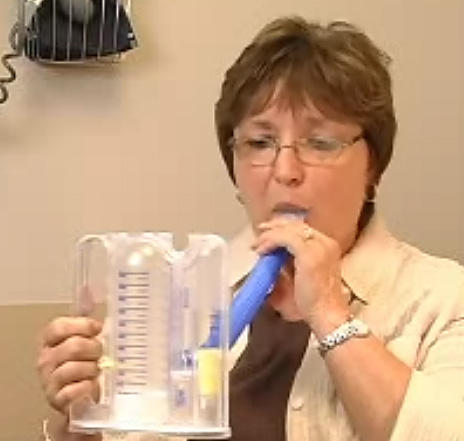- Sit up tall (no slouching!) on the edge of a chair or bed
- Lean slightly forward. (Lean from the hips, rather than stretching your neck or moving your head forward.)
- Breathe out normally.
- Place the mouthpiece of the device in your mouth, and seal your lips tightly around it.
- Breathe in slowly and as deeply as possible, raising the ball as close to the top of the column as you can.
- Hold your breath for 3 to 5 seconds, or for as long as possible.
- Allow the ball to fall to the bottom of the column.
- Remove the mouthpiece from your mouth and breathe out normally.
- Rest for a few seconds and repeat steps 1 through 8 at least 10 times, 3 times each day.
- Practice coughing to be sure your lungs are clear.
- After each session of at least 10 breaths, and coughing exercises, rest and breathe normally.
- Update your daily log with your progress.
Remember:
- Try to get the ball up to the top of the column with each breath.
- Breathing too quickly may cause you to feel light-headed, dizzy or, on rare occasion, to pass out. Take your time with the exercises. If you start to feel light-headed or dizzy, take a break and breathe normally until you feel better.
- If you have abdominal pain and your breathing exercises make the pain worse, talk to your doctor. You may need to take pain medication before doing your breathing exercises. It may be hard to take deep breaths if you're hurting, since expanding the lungs and chest cavity may lead to pressure on tender or wounded areas.
- After each set of 10 breaths, practice coughing to be sure your lungs are clear.
- Between now and the day of your surgery, do steps 1 through 8 at least 10 times, 3 times each day. (After your surgery, your nurse will ask you to do these breathing exercises 1 to 2 times each hour while you're awake.)
- It may be helpful to do your breathing exercises at the same times each day so they become a habit. That way you're more likely to remember to do them.
LEARN
You probably received your incentive spirometer and instructions on how to use it during the MSHOP introductory class you attended. If you need a refresher, you can watch this video.
TRACK
So that you, and your doctors, can see your progress, it's important to keep track of how often you use your incentive spirometer and do your other breathing exercises. This easy-to-use log will help you.
Remember, we want to see you do your breathing and coughing exercises at least three times every day. Doing them more often is even better.

